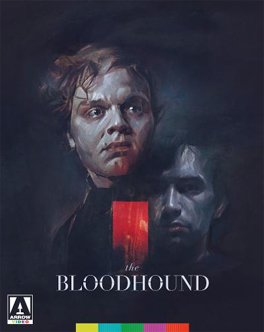 THE
BLOODHOUND (2020) Blu-ray
THE
BLOODHOUND (2020) Blu-rayDirector: Patrick Pichard
Arrow Video USA/MVD Visual
 THE
BLOODHOUND (2020) Blu-ray
THE
BLOODHOUND (2020) Blu-rayMumblecore cinema gets a gothic twist in THE BLOODHOUND, on Blu-ray from Arrow Video.
Homeless and couch-surfing, hipster photographer Francis (former child actor Liam Aiken, A SERIES OF UNFORTUNATE EVENTS) receives an invitation from childhood friend Jean Paul "JP" Luret (Joe Adler, THE MAZE RUNNER) to stay with him and his sister Vivian (Annalise Basso, OUIJA: ORIGIN OF EVIL) who because of some hereditary ailment retreated to the rural home their artist grandmother left them. Francis discovers that JP's high-strung nature has become even more extreme, alternately cold and excitable, and that Vivian seems an almost feral hermit, remaining in her bedroom during the days and prowling the house at night; both seemingly certain of their imminent deaths. Francis grows frustrated with the vagueness of JP's ailment, with holistic doctor Ricki (MURDER ONE's McNally Sagal) advising him to provide his friend with companionship and make sure he follows his routines. As his attempts to cheer up JP and draw out Vivian repeatedly fail, Francis too starts to feel that the sense of dread and encroaching death in the house may have a more corporeal nature in the form of JP's nightmare vision of THE BLOODHOUND.
The debut feature of AFI graduate Patrick Pachard after a series of AFI shorts, THE BLOODHOUND could be described as a riff on Poe's "The Fall of the House of Usher" although the director admits in the disc's extras that he had started developing his concept even before finishing the short story; and it is this sense of not being fully informed of the structure and themes of the story that makes the loosely structured, episodic THE BLOODHOUND more interesting than some other recent attempts at "restrained horror." Although the titular apparition and JP's sense of its motives are as heavy-handed as it is vague, there is also a sense that Francis' probing might not be so thorough due to his distressed circumstances, and that his own sense of guilt starts to make him as vulnerable as he believes his childhood friends to be. Adler in the extras looks a bit baby-faced, and the film demonstrates just how much the actor's mannerisms combined with the severe lighting can transform an actor, making him seem almost patterned as much after Vincent Price's Roderick Usher as Conrad Veidt's somnambulist in THE CABINET OF DR. CALIGARI, with the natural light daylight scenes making his fair skin look as palid as it does under the simulated blue moonlight. While German expressionism put its twist on the gothic genre with sometimes wildly avant-garde or rigidly forced perspective set designs, THE BLOODHOUND at first seems like a David Lynchian twist owing to its use of a striking Mid-century Modern house of nondescript rectangles on the outside and long, narrow-seeming rooms and glass walls on the inside. As the film progresses, it seems less Lynchian and more like a throwback to the late eighties and early nineties era of independent films far more so than its contemporaries (the film is advertised as coming from the producers of THE ENDLESS).
Shot on high definition video on location, THE BLOODHOUND's 1080p24 MPEG-4 AVC 1.66:1 widescreen has a crisp look that generally favors darker grading that lends some richness to certain colors while keeping the actors looking paler. Blacks are deep throughout, so much so that much of Basso's performance is shrouded in murk (although perhaps by design since Francis is not certain whether his encounters with her are in waking or dreaming). The DTS-HD Master Audio 5.1 track is generally front-oriented although with some surround atmosphere and modern horror low frequency rumble (although not to an excessive degree like your average Blumhouse pic). Optional English SDH subtitles are included.
The film is accompanied by an audio commentary by director Picard and editor David Scorca in which Picard discusses the origins of "the bloodhound" and some of the film's imagery, how in spite of his intention to overturn gothic tropes, some of them appear in a different form like the eccentricity of the homeopathic treatment, as well as the influence of Mid-century photographer Julius Shulman. On the production side, they discuss the location house and how the many mirrors and glass walls posed problems for framing, and having to tent the house since they could not shoot there at night. The two also appear with other cast and crew in "On the Trail of The Bloodhound: Behind the Scenes of a Modern Chiller" (45:21), a making-of featurette in which Picard discusses his AFI program days, an earlier short film titled "The Living Ghost" that he reworked into the feature, the enthusiasm of the casting director for the script and in finding him intriguing performers for the film, and the effect of the location on the look of the film and on the performances of the actors. The disc also includes four experimental short films by Picard – "Bad Dream" (1:06), "The Muffled Hammerfall in Action" (0:51), "The Mosaic Code" (0:32), and "Wiggleworm" (0:48) – but presumably THE LIVING GHOST could not be included due to rights issues with AFI short films. The first pressing includes an illustrated booklet featuring new writing on the film by Anton Bitel. (Eric Cotenas)